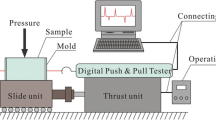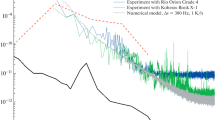Abstract
The problem of Earth surface deformation monitoring in regions of subsoil use and volcanic activity is considered. It is noted that available monitoring systems based on ground measurements and satellite technologies do not provide a complete solution of the deformation measurement problem. One promising direction in the field is related to the use of fiber-optic transducers. We suggest to use mathematical modeling results for assessing the applicability of these transducers. In the framework of the linear theory of elasticity, numerical results on Earth surface deformations were obtained for an averaged volcano model for various geometric parameters of the volcano source. An analysis of these results demonstrates that the use of fiber-optic transducers for volcanic activity recording and volcano eruption forecast is rather promising.
Similar content being viewed by others
References
J. M.W. Brownjohn, “Structural Health Monitoring of Civil Infrastructure,” Phil. Trans. Royal Soc. A 365, 589–622 (2007).
A. A. Panzhin, “The Spatial and Temporal Geo-Dynamic Monitoring at the Features of Subsurfase Use,” Gorn. Zh., No. 1, 39–43 (2012) [Eurasian mining (Engl. Transl.) No. 1, (2012)].
A. Baryakh, I. Sanfirov, V. Hronusov, et al., “Geological and Geomechanical Estimation of Karst Danger for City Area,” Studia Geotechnica et Mechanica XXXI(1), (2009).
A. L. Pustuev, Yu. P. Konovalova, and A. A. Martem’yanova, “Principles of Construction of Geodynamical Polygons in Large-Scale Use of Subsoil,” Gorn. Zh., No. 1, 32–36 (2012).
Geodesical Methods for Studying the Earth Crust on Geodynamic Polygons (TsNIIGAiK, Moscow, 1985) [in Russian].
N. G. Banks, R. I. Tilling, D. H. Harlow, and J.W. Ewart, “Volcano Monitoring and Short-Term Forecasts,” in Volcanic Hazards, Ed. by R. I. Washington (Am. Geophys. Union, 1989), pp. 51–80.
J. J. Dvorak and D. Dzurisen, “The Search for Magma Reservoirs and the Formation of Eruptive Vents,” Rev. Geophys. 35, 343–384 (1997).
F. Omori, “The Usu-San Eruption and the Earthquake and Elevation Phenomena II,” Bull. Imp. Earthq. Invest. Comm. 5, 101–137 (1913).
E. V. Levin, M. A. Magus’kin, V. F. Bakhtiyarov, et al., “Multisystem Geodetic Monitoring of Recent Crustal Movements in Kamchatka and the Commander Islands,” Vulkanolog. Seismolog., No. 3, 54–67 (2006).
G. Wadge, G. S. Mattiolli, and R. A. Herd, “Ground Deformation at Soufriere Hills Volcano, Montserrat during 1998–2000 Measured by Radar Interferometry and GPS,” J. Volcanol. Geotherm. Res. 152, 157–173 (2006).
Fiber-Optic Transducers. Introductory Course for Engineers and Scientists (Tekhnosfera, Moscow, 2008) [in Russian].
A. B. Efimov, T. Ya. Ershova, and M. A. Magus’kin, “Numerical Modeling of Earth Crust Current Displacements in the Region of Karym Volcano,” Vulkanolog. Seismolog., No. 6, 72–98 (1993).
Yu. B. Slezin, Mechanism of Volcanic Eruption (Stationary Model) (Nauchnyi Mir, Moscow, 1998) [in Russian].
Micron Optics, Inc. URL: http://www.micronoptics.com (date of appeal 20.05.2013).
Author information
Authors and Affiliations
Corresponding author
Additional information
Original Russian Text © V.P. Matveenko, V.A. Fedorova, I.N. Shardakov, 2013, published in Izvestiya Akademii Nauk. Mekhanika Tverdogo Tela, 2013, No. 5, pp. 46–52.
About this article
Cite this article
Matveenko, V.P., Fedorova, V.A. & Shardakov, I.N. Theoretical justification of the possibility of constructing a fiber-optic earth surface deformation monitoring system. Mech. Solids 48, 520–524 (2013). https://doi.org/10.3103/S0025654413050075
Received:
Published:
Issue Date:
DOI: https://doi.org/10.3103/S0025654413050075




